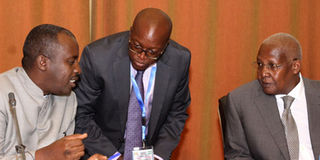AMISOM army chiefs oppose troop reduction

Officiating. The Chief of Defence Forces, Gen David Muhoozi (left) and the Foreign Affairs minister, Mr Sam Kutesa (right) during a meeting Military chiefs in Kampala on March 1, 2018. COURTESY PHOTO
What you need to know:
- Means. The troops lack force multipliers like helicopters and infantry fighting vehicles. Gen Muhoozi says wounded combatants sometimes die because they are not quickly evacuated from the battlefield.
- Replacements. The army chief reveals that the rate of attrition of fighting vehicles is more than the replacement.
KAMPALA. Military chiefs from five countries who deployed in war-torn Somalia want an end to the ongoing phased troop withdrawal.
On Wednesday, the army chiefs agreed that the troop strength that had been reduced from 22,126 to 21,626 be restored because the variation has made the troops thin on ground, making them vulnerable to Al-Shabaab attacks.
Uganda’s Chief of Defence Forces, Gen David Muhoozi, who chaired the meeting, said the troop variation is the reason the Uganda People’s Defence Forces (UPDF) halted “meaningful offensive operations” against the Al-Shabaab because troops were thin on ground.
“It was meaningless to continue capturing territory you can’t defend,” Gen Muhoozi told Daily Monitor in an exclusive interview on Wednesday.
The resolution
The UN Resolution 2372 of 2017 adopted a phased reduction and withdrawal of peacekeeping troops under the African Union Mission for Somalia (AMISOM) and a gradual hand over of security responsibilities to the Somali National Army (SNA).
However, Gen Muhoozi said the AU troop reduction in Somalia was not corresponding with the planned building of the Somali army.
“Instead of improving their posture, the number of troops were reduced and the idea was that the reduction should correspond with increment in SNA presence. We are reducing but the SNA is not being built,” he observed.
Under the provisions of the UN resolution, SNA was supposed to take over the captured areas as AMISOM troops continue to carry out offensive operations to liberate more territory from Al-Shabaab.
However, manpower and logistical constraints impeded this operational objective.
Without corresponding deployment of SNA troops and shortage of logistics like infantry fighting vehicles, the AMISOM rear bases became vulnerable to enemy assault.
Eye opener
Gen Muhoozi said AMISOM troops had to withdraw from some areas they had captured.
“We were awoken to the fact that the way the mission was going was not sustainable because of the mismatch between the force levels and the theatre that was too big,” he said.
He said UPDF did not have enough troops to carry out three roles of offensive, defensive and sustainment of operations.
It therefore became hard to be offensive to capture new territory or defend the one they captured and sustain its supply routes because of long routes to the forward bases.
Following the vulnerability of troops in the operational theatre, President Museveni called a meeting of all troop-contributing countries.
The first meeting was held last September at the sidelines of the UN General Assembly meeting in New York where they agreed to meet regularly and discuss the issues affecting the AMISOM troops in Somalia.
The troops lack force multipliers such as helicopters and infantry fighting vehicles.
Gen Muhoozi said wounded combatants sometimes die because they are not quickly evacuated from the battlefield.
“Sometimes we want an aircraft to evacuate a casualty and it does not come or it comes late when someone has already died,” Gen Muhoozi said.
Reduction of piracy
The army chief also said the rate of attrition of fighting vehicles was more than the replacement. He, however, said despite the challenges, AMISOM has made “tremendous” achievements in peace building and keeping in Somalia.
“Today, we can manifestly see reduced piracy, thanks to the work of AMISOM which has denied the terrorists access to land which was a springboard for destabilising the seas surrounding Somalia,” said Gen Muhoozi.
He also said the political developments around Somalia are another vital indicator of their collective progress in stabilising Somalia.




